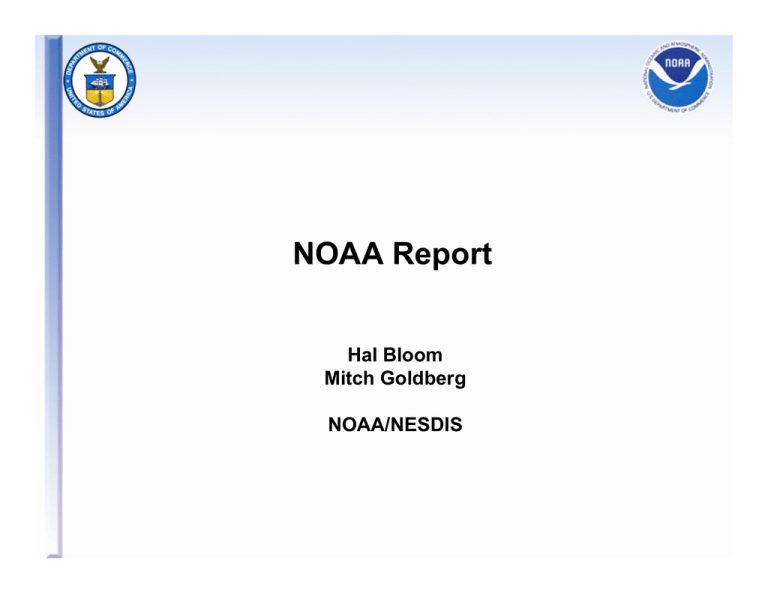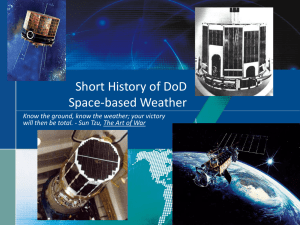NOAA Report Hal Bloom Mitch Goldberg NOAA/NESDIS
advertisement

NOAA Report Hal Bloom Mitch Goldberg NOAA/NESDIS Summary of Major Events at NESDIS (of interest to ITSC) • • NOAA/NASA addressing NPOESS Climate Sensors Letter of agreement signed with JAXA on GCOM interagency cooperation for GCOM – Two – 3 satellite series – GCOM-W AMSR2 (2012) – GCOM-C SGLI VIS/NIR Imager • • • • GSICS up and running GOES-R Algorithm Development up and running. Many R2O Transitions (See http://www.star.nesdis.noaa.gov/star/ smcd.php for annual report which describes last 3 bullets and other ITSC related science activities in detail) AMSR2 Channel Set Cente r Freq. [GHz] Band widt h [MHz ] 6.925/ 7.3 350 10.65 100 Polar izatio n Beam width [deg] (Ground res. [km]) Samplin g interval [km] 1.8 (35 x 62) 1.7 (34 x 58) 1.2 (24 x 42) V and H 10 18.7 200 0.65 (14 x 22) 23.8 400 0.75 (15 x 26) 36.5 1000 0.35 (7 x 12) 89.0 3000 0.15 (3 x 5) 5 Research to Operations • Product Processing Systems Transitioned to NESDIS/OSDPD – Solar Backscatter Ultraviolet Spectral Radiometer (SBUV/2) Version 8 Processing System – NESDIS Smoke Forecast Tool – AIRS Version 5 Algorithm Processing System – ATOVS Sounding Products for METOP – Microwave Integrated Retrieval System (MIRS) – Infrared Atmospheric Sounding Interferometer (IASI) Processing System – Total Ozone Estimates from MetOP GOME-2 • Data Assimilation Components Transitioned to NWS/NCEP – – – – – – – – Community Radiative Transfer Model (CRTM) includes aerosol/clouds/precipitation CRTM includes Zeeman splitting absorption, SSU/MSU for reanalysis Surface snow and ice emissivity model upgrade for AMSU/MHS/SSMIS GSI minimization including cloud liquid water COSMIC data assimilation AIRS (all FOVs) assimilation METOP-A AMSU, MHS, HIRS assimilation DMSP SSMIS F16 data assimilation Planned Missions ‐ Polar 2004 2005 2006 2007 2008 2009 2010 2011 2012 2013 2014 2015 2016 2017 2018 2019 2020 Early-AM Orbit DMSP 13 DMSP: SSMI/S DMSP 17 QuikScat DMSP 19 WindSat DMSP 20 JASON - Altimetry NPOESS C2 Mid-AM Orbit DMSP 16 NOAA 17 DMSP 18 METOP-A METOP-B EOS TERRA MODIS, PM Orbit NOAA 16 NOAA: AVHRR HIRS AMSU-A MHS SBUV/2 METOP: AVHRR HIRS IASI AMSU-A MHS GOME-2 ASCAT GRAS NOAA 18 C1: VIIRS, ATMS, OMPS, CrIS NOAA N-Prime NPP EOS AQUA AIRS, MODIS, AMSR-E 5 NPP: VIIRS, ATMS, OMPS, CrIS METOP-C NPOESS C1 C2: VIIRS, ATMS, OMPS, CrIS, MIS Current Status – De-manifested Sensors • Total Solar Irradiance Sensor (TSIS) – President’s FY2009 budget request includes support for instrument development and ongoing analyses to identify a suitable satellite platform for hosting the sensor – • Clouds and Earth Radiant Energy System (CERES) – – • Ocean Altimetry (ALT) – – • NOAA plans to provide operational continuity for satellite altimetry data with a Jason-3 mission Jason-3 is a NOAA-EUMETSAT partnership mission, planned for launch in 2013 Ozone Mapping and Profiler Suite (OMPS) Limb sensor – – • A CERES instrument is approved for flight on the NPOESS Preparatory Project (NPP) in 2010 President’s FY2009 budget request includes funds to build another CERES instrument to fly on the first NPOESS planned for 2013 launch Approved for flight on NPP Resources not identified for NPOESS OMPS-Limb Aerosol Polarimeter Sensor (APS) – NOAA is monitoring NASA’s development of APS scheduled to launch in March 2009 on the GLORY mission and will evaluate it before making a decision Continuity of GOES Operational Satellite Program Calendar Year 2004 2005 2006 2007 2008 2009 2010 2011 2012 2013 2014 2015 2016 2017 2018 2019 2020 GOES 10 Backup GOES 11 GOES West GOES 12 GOES East GOES 13 On-orbit Spare GOES O GOES P GOES R GOES S Satellite is operational beyond design life Approved __________________ On-orbit GOES storage Operational 3/19/2008 Global Space-based InterCalibration System (GSICS) • NESDIS/STAR/SMCD is coordination center for WMO GSICS – NOAA, NASA, EUMETSAT, JMA, CMA, KMA, CNES • Goal – Improved sensor characterisation through satellite intercalibration for improved weather and climate applications • 2007 – – – • Commissioned routine LEO to LEO intercalibration GSICS Website with online instrument performance and intercalibration Quarterly Newsletter 2008 – – – Developed LEO to GEO intercalibration method Developed AIRS spectral gap filling technique Commission intercalibration of MTSAT, MSG, GOES and FY2 Infrared Imagers with IASI and AIRS. Simultaneous Nadir Overpass (SNO) Method -a core component of GSICS POES intercalibration • Useful for remote sensing scientists, climatologists, as well as calibration and instrument scientists •Support new initiatives (GEOSS and GSICS) • Significant progress are expected in GOES/POES intercal in the near future •Has been applied to microwave, vis/nir, and infrared radiometers for on-orbit performance trending and climate calibration support •Capabilities of 0.1 K for sounders and 1% for vis/nir have been demonstrated in pilot studies GOES vs. POES GOES 10.7 μm Co-locations with AIRS, 21feb02 1. FOV instead of large area 2. Not restricted to near nadir SRF Shift for HIRS Channel 6 Without SRF shift With SRF shift 0.2 cm-1 Since the HIRS sounding channels are located at the slope region of the atmospheric spectra, a small shift of the SRF can cause biases in observed radiances. Outcome: Less reliance on radiance tuning. Instead modify radiative transfer model Satellite Intercalibration using SNO improves the MSU time series • NESDIS/STAR completed a recalibration on the MSU atmospheric channels for NOAA 10 to 14 • The current MSU data are well merged and provide accurate climate trend values. • The radiance data are well merged for assimilation in reanalysis systems. Intersatellite bias removal among the NOAA MSU instruments are crucial for climate trend detection. Courtesy of C. Zou Top: Ocean-averaged MSU channel 2 time series for NOAA 10, 11, 12, and 14 for 1987-2007 before the SNO calibration; Bottom: Anomaly time series for MSU channels 2, 3, and 4 after the SNO recalibration. The abbreviations Middle Troposphere, Temperature Tropopause and Stratosphere TMT, TTS, and TLS refer respectively to Temperature, and Temperature Lower Stratosphere. Community Radiative Transfer Model (CRTM) • • • • • • • • • • • • • • • • • • • • • • • Supported Instruments GOES-R ABI Metop IASI TIROS-N to NOAA-18 AVHRR TIROS-N to NOAA-18 HIRS GOES-8 to 13 Imager channels GOES-8 to 13 sounder channel 08-13 Terra/Aqua MODIS Channel 1-10 METEOSAT-SG1 SEVIRI Aqua AIRS Aqua AMSR-E Aqua AMSU-A Aqua HSB NOAA-15 to 18 AMSU-A NOAA-15 to 17 AMSU-B NOAA-18 MHS TIROS-N to NOAA-14 MSU DMSP F13 to15 SSM/I DMSP F13,15 SSM/T1 DMSP F14,15 SSM/T2 DMSP F16 SSMIS NPP ATMS Coriolis Windsat SSU and MSU Significance: CRTM framework is designed to accelerate transition of new radiative transfer science for assimilation of operational and research satellite data in NWP models and to improve the retrieval technology in satellite remote sensing system Improved Snow and Sea Ice Emissivity Models Resulted in More MHS Data Used in NCEP GFS • Microwave Humidity Sensor on board NOAA-18 and METOP-A satellites include 5 water vapor channels • MHS, especially over snow and sea ice conditions, is highly affected by variable emissivity • Currently, only 20-30% MHS data passed quality control in NCEP/GSI • STAR/JCSDA improved MHS snow and sea ice emissivity models results in more than 70% data passing QC • The impact of the MHS data using the new emissivity model is positive Assimilation of COSMIC Data in GSI/GFS Produce Positive Impacts • Anomaly correlation as a function of forecast day for two different experiments: – PRYnc (assimilation of operational obs ), – PRYc (PRYnc + COSMIC refractivity) • 1,000 COSMIC profiles per day are assimilated • Impacts are significantly positive in SH • In general, the impact of the COSMIC data is more seen in upper troposphere Summary • • • • NOAA is poised for NPOESS and GOES-R New Satellite Partners (JAXA) New International collaboration (GSICS) Scientifically NOAA is making great advances in new product generation capability and data assimilation. • Focusing on new integrated software systems – Multisensor algorithms (e.g. MIRS and Hyperspectral IR) – Integrated Cal/Val systems – CRTM with more trace gases and improved land emissivity (MW and infrared)



![Eduardo A. Araujo-Pradere [], CIRES, University of Colorado, Solar Minimum](http://s2.studylib.net/store/data/013086460_1-158f16f4991b8d654a2183bbdcda9c6c-300x300.png)